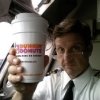Can someone please tell me if pilots are allowed to fly once they require reading glasses? Even the pilots who have 20/15 or 20/10 vision will eventually need reading glasses once they are over 40. How then do such pilots fly? Do they take such glasses with them in flight? Do fighter pilots stop flying after 40 once they need such glasses?
Thanks.
Once you are winged, the uncorrected 20/40 vision requirement for pilots changes. As a SNA (Class I, no Service Group), the vision requirements are 20/40. Once winged, Class I (Pilots) are further classified as Service Group 1-3. These service groups are defined:
Class I: Naval Aviators and Student Naval Aviators (SNA). Designated Naval aviators are subdivided into three Medical Service Groups based upon the physical requirements of their specific flight duty assignment
Medical Service Group 1: Aviators qualified for unlimited or unrestricted flight duties
Medical Service Group 2: Aviators restricted from shipboard aircrew duties (include V/STOL) except helicopter.
Medical Service Group 3: Aviators restricted to operating aircraft equipped with dual controls and accompanied on all flights by a pilot or copilot of Medical Service Group 1 or 2, qualified in the model of aircraft operated. A waiver to medical Service Group 3 includes pilot-in-command (PIC) authority unless PIC authority is specifically restricted.
The eyesight requirements come from section 12.3 of the
NAMI Aeromedical Waiver Guide:
12.3 DECREASED VISUAL ACUITY
Last Revised: APR 15 Last Reviewed: APR 15
AEROMEDICAL CONCERNS: Decreased visual acuity degrades lookout and target acquisition.
WAIVER: A waiver for visual acuity less than standards may be considered in designated individuals, provided the central and peripheral retina is normal and all other visual standards are met.
 Since we are talking standards, SNA Standards are:
All applicants for pilot training must meet Class I standards except as follows:
Since we are talking standards, SNA Standards are:
All applicants for pilot training must meet Class I standards except as follows:
Visual Acuity, Distant and Near: Uncorrected visual acuity must not be less than
20/40 each eye,
correctable to 20/20 each eye using a Sloan letter, crowded, eye chart
(Goodlite). Vision testing procedures shall comply with those outlined on the Aerospace Reference and Waiver Guide Physical Exams section.
Refractive Limits: If uncorrected distant visual acuity is less than 20/20 either eye, a manifest refraction must be recorded for the correction required to attain 20/20. If the candidate’s distant visual acuity is 20/20, a manifest refraction is not required. Total myopia may not be greater than -1.50 diopters in any meridian, total hyperopia no greater than +3.00 diopters in any meridian, or astigmatism no greater than -1.00 diopters. The astigmatic correction shall be reported in minus cylinder format.
Cycloplegic Refraction: This is required for all candidates to determine the degree of spherical ametropia. The refraction should be performed to maximum plus correction to obtain best visual acuity. Due to the effect of lens aberrations with pupil dilation, visual acuity or astigmatic correction, which might disqualify the candidate, should be disregarded if the candidate meets the standards for visual acuity and astigmatism with manifest refraction. A cycloplegic refraction should be performed at least 30 minutes after instillation of 2gtts (5 minutes apart) 1% cyclopentolate.





